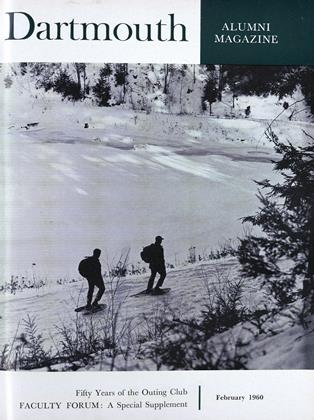PRECISION VALLEY: THE MACHINE TOOL COMPANIES OF SPRINGFIFLD VERMONT.
February 1960 HERBERT W. HILLBy Wayne G. Broehl, Jr.Englewood Cliffs, N. J.: Prentice-Hall, 1959.274 pp. $5.95.
Northern New England, for many Americans and Mr. Arnold Toynbee, is a region of mountains, scenery, and resorts, inhabited by a thinly scattered population which has found the going too hard to develop a civilized society. Those who know it, beyond such alien towns as Hanover, are well aware of the true facts. There are mountains, but as Ethan Allen once said, even God Almighty cannot make two mountains without putting a valley in between, and in the valleys all sorts of unexpected things can be found. One of these valleys is the subject of Mr. Broehl's well-done book, and it is a valley that has long needed a history.
Springfield, Vermont, is a small industrial town in a rural state. Astride the Black River three or four miles from where it joins the Connecticut, it was once, like dozens of towns around here, using water power to run little mills. Some of these towns, producing shoes or paper or cloth or metal products, have disappeared; others have become cities.
Springfield has stayed small, but it produces one-sixth of the value of manufactures in Vermont and over five per cent of all the machine tools of the country. Its three main plants - Jones and Lamson Machine Company, Fellows Gear Shaper Company, and Bryant Chucking Grinder Company - were not imported from some more "favored" spot, but were created and developed by native Yankees, and run by them, to the immense profit of all concerned, including the United States.
Those who like Vermont history, or the story of real, free-enterprise American business, will find the well-illustrated book an interesting one. Mr. Broehl includes not only the story of the three companies, but their place in the general life of the region and of industrial America, together with a clear description of the peculiar problems of the machine tool business. All this is not easy to do, and if the book at any point falls out of balance, perhaps it is in slighting somewhat the local impact of these industries or in providing what might seem too brief a discussion of labor relations.
Mr. Broehl has made a real contribution to local history and to business history, and ought to go on to some of the other industries of northern New England now that he has made the break from the Ohio truck lines of his earlier book. More studies like this are needed.
 View Full Issue
View Full Issue
More From This Issue
-
 Feature
FeatureFIFTY YEARS OF THE DOC
February 1960 By ROBERTS W. FRENCH '56 -
 Feature
FeatureHow Green Is Squaw Valley
February 1960 By CLIFFORD L. JORDAN '45 -
 Feature
FeatureHow Public Is Music?
February 1960 By JAMES A. SYKES -
 Feature
FeatureThe Broadcasters and the Government
February 1960 By ELMER E. SMEAD -
 Feature
FeatureIndividuality in Forest Trees
February 1960 By F. HERBERT BORMANN -
 Feature
FeatureA Pioneer in Electronics
February 1960 By J.B.F.
HERBERT W. HILL
-
 Article
ArticleDARTMOUTH'S SKIPPER
June 1944 By HERBERT W. HILL -
 Books
BooksTHE UNITED STATES.
June 1954 By HERBERT W. HILL -
 Books
BooksDEMOCRACY IN THE CONNECTICUT FRONTIER TOWN OF KENT.
October 1961 By HERBERT W. HILL -
 Books
BooksTRAVELS IN NORTH AMERICA IN THE YEARS 1780, 1781, and 1782.
MARCH 1964 By HERBERT W. HILL -
 Books
BooksIDEAS, WEALS, AND AMERICAN DIPLOMACY: A HISTORY OF THEIR GROWTH AND INTERACTION.
OCTOBER 1966 By HERBERT W. HILL -
 Books
BooksAS A CITY UPON A HILL.
FEBRUARY 1967 By HERBERT W. HILL
Books
-
 Books
BooksAlumni Books
NovembeR | decembeR -
 Books
BooksTHE PLANS OF MEN
July 1940 By C. N. Allen '24, Harold G. Rugg -
 Books
BooksGreat Companions.
NOVEMBER 1927 By Charles D. Adams -
 Books
BooksBriefly Noted
JUNE 1970 By F.H. -
 Books
BooksTHE CAUGHT IMAGE.
JULY 1964 By HENRY L. TERRIE JR. -
 Books
BooksSPAIN'S IRON AND STEEL INDUSTRY.
OCTOBER 1968 By JOHN HURD '21


